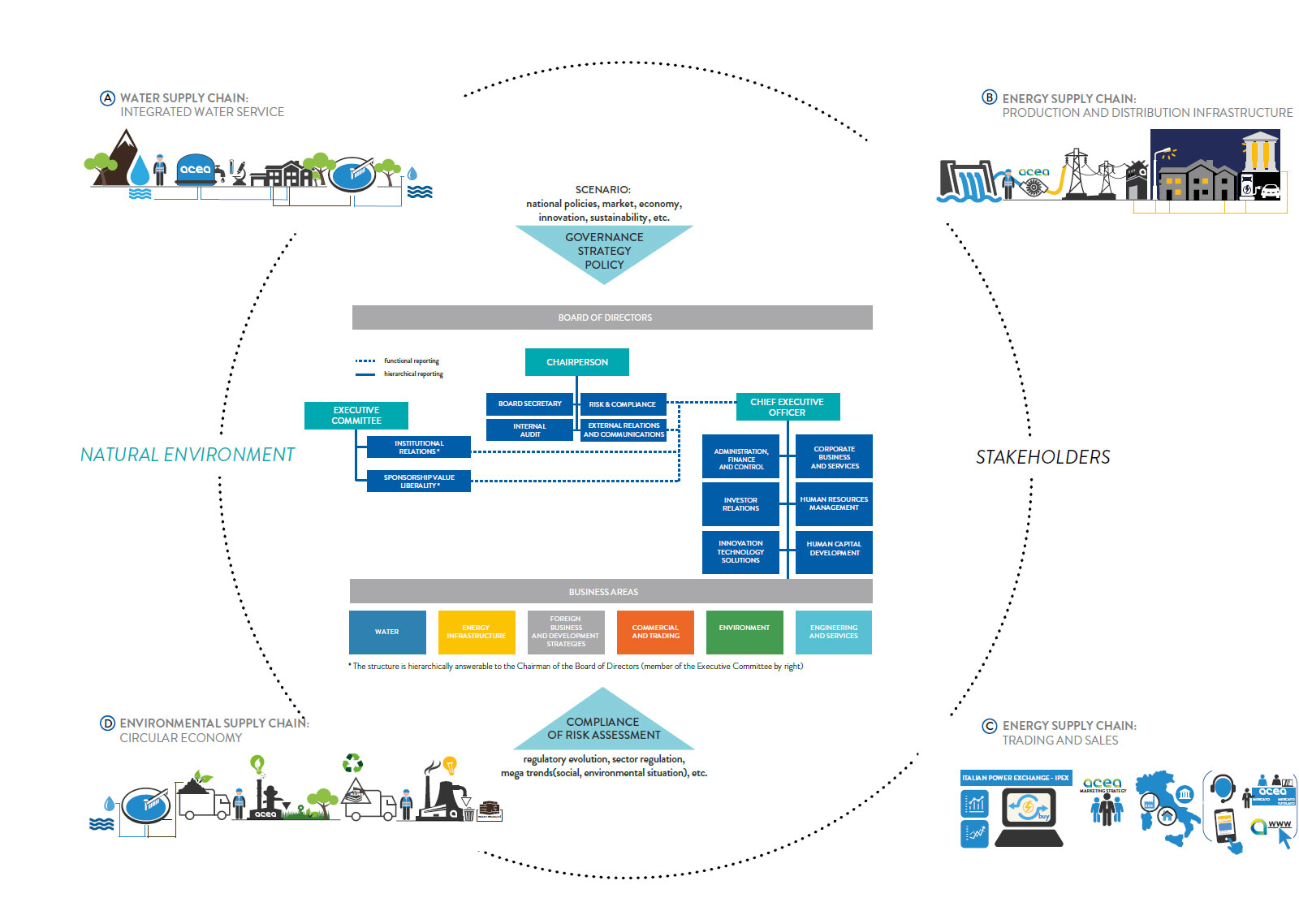Discover the Acea Group online 2019 Consolidated Report
Acea Organisational Model

Acea is one of the major Italian multiutilities, and has been quoted on the stock exchange since 1999.
Acea adopts an operational model based on an organisational layout in line with the Strategic Business Plan consolidating its role to govern, guide and control the Holding not only with the current business portfolio focused on areas of greater value, but also on the strategic development of the Group in new business segments and territories. Acea's macrostructure is based around the corporate functions and six industrial areas - Environment, Commercial and Trading, Water, Energy Infrastructure, Engineering and Services and Overseas.
The activities of each business segment are described below.

Water
The Acea Group is the top Italian operator in the water sector serving 9 million people. The Group manages the integrated water service in Rome and Frosinone and in the respective provinces, as well as in other parts of Lazio, in Tuscany, Umbria and Campania.

Energy Infrastructure
The Acea Group is a major operator in Italy with about 10 TWh of electricity distributed in Rome. The Group also manages the public and artistic lighting of the capital for a total of 224,000 light bulbs. The Acea Group is committed to energy efficiency projects and the development of new technologies, such as smart grids and electric mobility, through particularly innovative pilot projects. Consistent with the strategy of the Industrial Plan, the Acea Group has returned to growth in the renewable energy market through the acquisition of a number of photovoltaic plants in Italy.

Commercial and Trading
The Acea Group is a major operator in Italy in the sale of electrical energy and offers innovative and flexible solutions for the supply of electricity and natural gas to consolidate its position as a dual fuel operator. Acea operates in the market segments of medium-sized businesses and families, striving to improve the quality of its services in particular as far as web and social channels are concerned. It supervises the Group's energy management policies.

Overseas
Through this Area, the Acea Group manages water activities in Latin America and its objective is to make the most of development opportunities in other businesses related to those already held in Italy.
It is present in Honduras, Dominican Republic, Colombia and Peru, serving approximately 4 million people. The activities are carried out in partnership with local and international partners, including through staff training and the transfer of know-how to local entrepreneurs.

Environment
The Acea Group is one of the leading national players with more than 1 million tonnes of waste processed each year. It manages the main waste-to-energy plant and the largest composting plant in Lazio. In particular, the Group develops investments in the waste to energy business, considered high potential, in accordance with the strategic goal of producing energy from waste and protecting the environment.

Engineering and Services
The Group has developed know-how at the forefront in the design, construction and management of integrated water systems: from the source to the aqueducts, from distribution to the sewer network, and treatment. It develops applied research projects aimed at technological innovation in the water, environmental and energy sectors. Laboratory services are of particular importance.

The Acea business model

WATER SUPPLY CHAIN: INTEGRATED WATER SERVICE
The water supply chain: starting from a careful analysis of springs and groundwater and the potential impacts of operational processes on them – for example, by defining and monitoring water districts and preparing water balances – Acea controls and guarantees the quality of water during collection and distribution in compliance with the regulatory standards envisaged for end uses. The same care is devoted to wastewater and advanced treatment phases to recover useful material and return the resource to the environment in the best possible conditions for its natural cycle to resume.
ENERGY SUPPLY CHAIN: PRODUCTION AND DISTRIBUTION INFRASTRUCTURE
Production and distribution of electricity: Acea produces energy at hydroelectric plants, waste-to-energy plants, thermoelectric plants (high-efficiency cogeneration), anaerobic digestion plants (biogas) and photovoltaic plants, for a total generation from renewable sources of about 70%. Users receive electricity thanks to the distribution grid managed and developed by Acea. The digital and innovative development in the services, stimulated and required by a constantly evolving market, commits the Distributor to tend towards smart city solutions. This is accompanied by a resilient management of the networks by which it is possible to support a future shift and increase in the uses of the electrical vector.
ENERGY SUPPLY CHAIN: TRADING AND SALES
Sale of energy and gas: the purchase of commodities (energy and gas) takes place by means of bilateral contracts or exchanges on market platforms (Electronic stock exchange) where Acea Energia, provision in order to resupply clients according to its respective commercial policies. The Company develops relations with the clients, based on their typology, by means of increasingly more innovative and digital contact channels, however retaining traditional tools such as the telephone and public counters. The promotion of its products takes place through pull channels (shop, website, branches) as well as through sales agencies that are selected, trained and their commercial practices monitored.
ENVIRONMENTAL SUPPLY CHAIN: CIRCULAR ECONOMY
Waste valorisation and circular economy: the environmental supply chain has as its objective the valorisation of waste through the reduction of volumes, their treatment, conversion into biogas, transformation into compost for agriculture and floriculture and recycling into material that is reusable in production processes. In particular, with a view to circular economy, Acea exploits the integration into water activities to recover sludge from water purification and send it for treatment to become compost, also committing itself to the growth of its market position and operational capacity through plant acquisition and development projects.